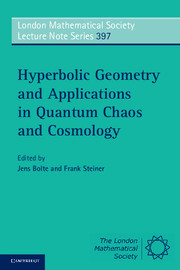Book contents
- Frontmatter
- Contents
- List of Contributors
- Preface
- I Hyperbolic Geometry
- II Selberg's Trace Formula: An Introduction
- III Semiclassical Approach to Spectral Correlation Functions
- IV Transfer Operators, the Selberg Zeta Function and the Lewis-Zagier Theory of Period Functions
- V On the Calculation of Maass Cusp Forms
- VI Maass Waveforms on (Γ0(N), χ) (Computational Aspects)
- VII Numerical Computation of Maass Waveforms and an Application to Cosmology
- Index
- References
V - On the Calculation of Maass Cusp Forms
Published online by Cambridge University Press: 05 January 2012
- Frontmatter
- Contents
- List of Contributors
- Preface
- I Hyperbolic Geometry
- II Selberg's Trace Formula: An Introduction
- III Semiclassical Approach to Spectral Correlation Functions
- IV Transfer Operators, the Selberg Zeta Function and the Lewis-Zagier Theory of Period Functions
- V On the Calculation of Maass Cusp Forms
- VI Maass Waveforms on (Γ0(N), χ) (Computational Aspects)
- VII Numerical Computation of Maass Waveforms and an Application to Cosmology
- Index
- References
Summary
Introduction
My mini-course at the Reisensburg meeting was intended mainly for students and focused on the general topic of “Maass Waveforms and Their Computation.” The material that I spoke about was taken from a variety of sources, chief among them being
(for lecture 1) [8], [9, pp. 294(bottom)-295(top)], [14, p. 279 (para 1) and Fig. 8], [13, eqs. (5.1),(5.2)];
(for lecture 2) [8], [16, §8.2], [11, §3], [9], [5], [18], [14, §6], [15];
(for lecture 3) [11, §§4,5], [10, eqs. (9.6),(9.9),(9.13),(1.2)], [2].
As part of lecture 2, I gave a brief description of a general method – originating in an idea of Harold Stark – for calculating Maass cusp forms on cofinite Fuchsian groups Γ\H having one cusp.
(Recall that a cusp form is simply a waveform which vanishes exponentially fast in each cusp; cf. [8, p. 140].)
The method, which is partly heuristic, has a certain robustness (as well as generality) that was lacking in both [10] and [12].
Reference [9] contains an outline of how matters are implemented in the case of a Hecke triangle group GN having signature (0,3;π/2,π/N,π/∞).
Though the underlying idea is simple enough, space limitations precluded saying more than just a few words about the algorithm's operational particulars in [9]. Good speaking style necessitated a similar abridgment in lecture 2.
Prompted in part by ongoing interest in utilizing Maass cusp forms as a “test basin” for a host of quantum chaos questions, we recently made available over the web a number of typical codes from [9]. See [7].
- Type
- Chapter
- Information
- Publisher: Cambridge University PressPrint publication year: 2011
References
- 3
- Cited by

